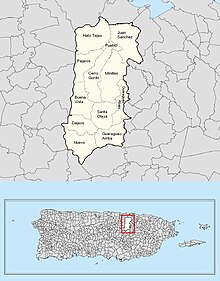Bayamón, Puerto Rico
[7] In 1821, Marcos Xiorro, an African slave, planned to lead a revolt against the sugarcane plantation owners and the Spanish colonial government in Puerto Rico.[9] Puerto Rico was ceded by Spain in the aftermath of the Spanish–American War under the terms of the Treaty of Paris of 1898 and became a territory of the United States.In 1899, the United States Department of War conducted a census of Puerto Rico finding that the population of Bayamón was 19,940.[15] Bayamón is Puerto Rico's second-most populous municipality and is part of the large metropolitan area centered around San Juan.Other cities included in the metropolitan area are Guaynabo, Cataño, Toa Baja, Canóvanas, Carolina and Trujillo Alto.The municipal buildings, central square and large Catholic church are located in a small barrio referred to as "el pueblo".Of the 742 places that were on the list in 2014, the following barrios, communities, sectors, or neighborhoods were in Bayamón: Abra Estrecha, Barriada Vista Alegre, Juan Sánchez, Nuevo, Bda.Bayamon also hosts the Braulio Castillo Theater, the Francisco Oller Museum, and the José Celso Barbosa Monument.[29] Ron del Barrilito located in the Hacienda Santa Ana is the oldest rum distillery in Puerto Rico.The Festival de la Santa Cruz is a religious and cultural celebration that generally features parades, games, artisans, amusement rides, regional food, and live entertainment.The Rafael Martínez Nadal Sports Complex's main feature is the Pepín Cestero indoor court, where much of the city's minor league basketball and volleyball major events take place.Also, the Efraín Calcaño Alicea Sports Complex located in the Lomas Verdes community is home to much of the track and field and swimming events in the region.The city also has many smaller baseball parks, open basketball courts, soccer fields, gymnasiums, and communal centers available to the community.[34] Puerto Rico was ceded by Spain in the aftermath of the Spanish–American War under the terms of the Treaty of Paris of 1898 and became a territory of the United States.The main colors of the shield are blue and silver, representing the waters of the Bayamón River and recalling that it was on these banks that the first hydraulic sugarcane refinery of Puerto Rico was established in 1549.[44] The five-tower crown, which is used for cities, was assigned to Bayamón as an exception for its extraordinary urban development, the magnitude of its population and for its religious dignity, which will possibly be raised to become Episcopal seat.The motto "IN HOC SIGNO VINCES" makes reference to Emperor Constantine when in the 4th century had the vision in which the victory was promised to him if it accepted the cross of Christianity as his banner.Due to its population and location within the San Juan metropolitan region, Bayamón is home to many public and private schools.The lone line of the Tren Urbano of the San Juan metropolitan area ends at Bayamón station, and three of its stops are located within the city.The Deportivo station, located off the PR-2 Highway, is near the Santa Rosa Mall, the Bayamón Court of First Instance, and the Onofre Carballeira Sports Complex which contains the Juan Ramón Loubriel Stadium and the Ruben Rodríguez Coliseum.








BayamoMunicipalityBayamón City HallInvención de la Santa Cruz ParishJuan Ramón Loubriel StadiumPuerto Rico National CemeteryTren UrbanoDeportivo stationBayamón Correctional ComplexSovereign stateUnited StatesCommonwealthPuerto RicoBarriosBuena VistaCerro GordoDajaosGuaraguao AbajoGuaraguao ArribaHato TejasJuan SánchezMinillasPájarosBayamón barrio-puebloSanta OlayaRamón Luis Rivera Jr.Demonym(s)Time zoneZIP CodesArea code787/939Major routescoastal plainGuaynaboToa AltaNaranjitoToa BajaCatañoAguas BuenasComeríoSan Juan metropolitan areadowntownadministrative centerBayamón Pueblo2020 censusarchipelago and islandSan JuancaciqueChicharrónPork Rindlocal sports teampopular tourist educational attractiontraffic congestionTimeline of Bayamón, Puerto RicoSpanish colonistBayamónSpanishits current parish churchMarcos XiorroAfricansugarcaneplantationearthquake in 1867Spanish–American WarTreaty of Paris of 1898United States Department of WarcensusFirst National City Bank of New YorkChase Manhattan BankBanco Popular de Puerto RicoVIII Pan American GamesHurricane MariaGoya FoodsmogoteNorthern Karst BeltBayamón Rivermetropolitan areaCanóvanasCarolinaTrujillo AltoLuis Muñoz Marín International AirportRío BayamónRío HondoRío MinillasRío BucarabonesRío Cuesta Arribaminor civil divisionsPuerto Rico Office for Socioeconomic and Community Developmentsocial exclusionBraulio CastilloFrancisco OllerJosé Celso BarbosaParque de las CienciaskarsticEl parque del trenUnited AirlinesPlaza del SolPlaza Rio Hondosuspension bridgeCOVID-19 pandemic in Puerto RicoPuerto Rico Tourism Companynature trailpatron saintPuerto Rico IslandersVaqueros de BayamónBaloncesto Superior NacionalColiseo Rubén Rodríguezthe name of the baseball clubProfessional Baseball League of Puerto RicovolleyballVaqueras de BayamónLiga de Voleibol Superior FemeninoPuerto Rico FCNorth American Soccer LeagueBayamón FCBayamón Soccer ComplexboxingAlexis ArgüelloAlfredo EscaleraThe Bloody Battle of BayamonLuis Del ValleWilfredo VazquezInternational Boxing Hall of FameHector CamachoLiga Puerto RicoRubén Rodríguez Coliseum